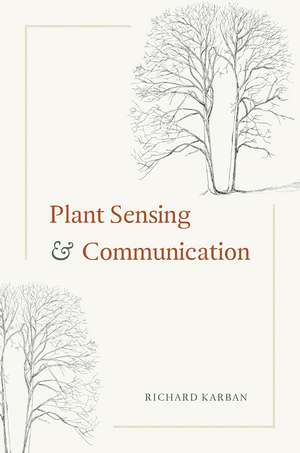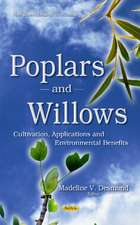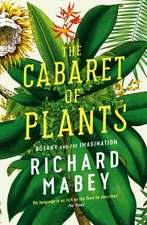Plant Sensing and Communication: Interspecific Interactions
Autor Richard Karbanen Limba Engleză Paperback – 30 iun 2015
The news that a flowering weed—mousear cress (Arabidopsis thaliana)—can sense the particular chewing noise of its most common caterpillar predator and adjust its chemical defenses in response led to headlines announcing the discovery of the first “hearing” plant. As plants lack central nervous systems (and, indeed, ears), the mechanisms behind this “hearing” are unquestionably very different from those of our own acoustic sense, but the misleading headlines point to an overlooked truth: plants do in fact perceive environmental cues and respond rapidly to them by changing their chemical, morphological, and behavioral traits.
In Plant Sensing and Communication, Richard Karban provides the first comprehensive overview of what is known about how plants perceive their environments, communicate those perceptions, and learn. Facing many of the same challenges as animals, plants have developed many similar capabilities: they sense light, chemicals, mechanical stimulation, temperature, electricity, and sound. Moreover, prior experiences have lasting impacts on sensitivity and response to cues; plants, in essence, have memory. Nor are their senses limited to the processes of an individual plant: plants eavesdrop on the cues and behaviors of neighbors and—for example, through flowers and fruits—exchange information with other types of organisms. Far from inanimate organisms limited by their stationary existence, plants, this book makes unquestionably clear, are in constant and lively discourse.
In Plant Sensing and Communication, Richard Karban provides the first comprehensive overview of what is known about how plants perceive their environments, communicate those perceptions, and learn. Facing many of the same challenges as animals, plants have developed many similar capabilities: they sense light, chemicals, mechanical stimulation, temperature, electricity, and sound. Moreover, prior experiences have lasting impacts on sensitivity and response to cues; plants, in essence, have memory. Nor are their senses limited to the processes of an individual plant: plants eavesdrop on the cues and behaviors of neighbors and—for example, through flowers and fruits—exchange information with other types of organisms. Far from inanimate organisms limited by their stationary existence, plants, this book makes unquestionably clear, are in constant and lively discourse.
Preț: 236.97 lei
Nou
Puncte Express: 355
Preț estimativ în valută:
45.34€ • 47.47$ • 37.52£
45.34€ • 47.47$ • 37.52£
Carte disponibilă
Livrare economică 17-31 martie
Livrare express 28 februarie-06 martie pentru 22.23 lei
Preluare comenzi: 021 569.72.76
Specificații
ISBN-13: 9780226264707
ISBN-10: 022626470X
Pagini: 240
Ilustrații: 16 halftones, 9 line drawings, 6 tables
Dimensiuni: 152 x 229 x 20 mm
Greutate: 0.32 kg
Ediția:1
Editura: University of Chicago Press
Colecția University of Chicago Press
Seria Interspecific Interactions
ISBN-10: 022626470X
Pagini: 240
Ilustrații: 16 halftones, 9 line drawings, 6 tables
Dimensiuni: 152 x 229 x 20 mm
Greutate: 0.32 kg
Ediția:1
Editura: University of Chicago Press
Colecția University of Chicago Press
Seria Interspecific Interactions
Notă biografică
Richard Karban is professor of entomology and a member of the Center for Population Biology at the University of California, Davis. He is coauthor of Induced Responses to Herbivory, also published by the University of Chicago Press, and How to Do Ecology: A Concise Handbook.
Cuprins
Acknowledgments
Chapter 1. Plant Behavior and Communication
1.1 Plants and animals are different but also similar
1.2 Working definitions
1.3 Plant sensing and communication—organization of this book
Chapter 2. Plant Sensory Capabilities
2.1 Plants sense their environments
2.2 Plants sense light
2.3 Chemical sensing
2.4 Mechanical sensing—touch
2.5 Plant sensing of temperature, electricity, and sound
Chapter 3. Plant Learning and Memory
3.1 Do plants learn?
3.2 Learning, memory, and light
3.3 Learning, memory, and perception of chemicals, resources, pathogens, and herbivores
3.4 Learning, memory, and touch
3.5 Learning, memory, and cold
3.5 Transgenerational memory
Chapter 4. Cues and Signals in Plant Communication
4.1 The nature of cues and signals
4.2 Plant competition—light and hormonal cues
4.3 Cues used in plant defense
4.4 Cues and signals emitted by plants that animals sense
Chapter 5. Plant Responses to Cues about Resources
5.1 General characteristics of plant responses
5.2 Plants forage for resources
5.3 Integrating resource needs
Chapter 6. Plant Responses to Herbivory
6.1 Induced responses as plant defenses
6.2 Volatile signals and communication between ramets and individuals
6.3 Indirect defenses against herbivores
6.4 Visual communication between plants and herbivores
Chapter 7. Plant Communication and Reproduction
7.1 Pollination and communication
7.2 Seed dispersal and communication
Chapter 8. Microbes and Plant Communication
8.1 Microbes are critical for plant success
8.2 Plants recognize pathogens
8.3 Infested plants attract the microbial enemies of their attackers
8.4 Plants communicate with mycorrhizal fungi
8.5 Plants communicate with N-fixing bacteria
Chapter 9. Plant Sensing and Communication as Adaptations
9.1 Plant senses and emission of cues—adaptive traits?
9.2 Case studies of adaptations
Chapter 10. Plant Sensing and Communication in Agriculture and Medicine
10.1 Manipulating the sensing and communication process
10.2 Manipulating resource acquisition and allocation
10.3 Manipulating tolerance to abiotic stress
10.4 Manipulating resistance to pathogens
10.5 Manipulating resistance to herbivores
10.6 Manipulating reproductive timing and effort
10.7 As a source of medicines
10.8 Plant sensing in the future of mankind
References
Index
Chapter 1. Plant Behavior and Communication
1.1 Plants and animals are different but also similar
1.2 Working definitions
1.3 Plant sensing and communication—organization of this book
Chapter 2. Plant Sensory Capabilities
2.1 Plants sense their environments
2.2 Plants sense light
2.3 Chemical sensing
2.4 Mechanical sensing—touch
2.5 Plant sensing of temperature, electricity, and sound
Chapter 3. Plant Learning and Memory
3.1 Do plants learn?
3.2 Learning, memory, and light
3.3 Learning, memory, and perception of chemicals, resources, pathogens, and herbivores
3.4 Learning, memory, and touch
3.5 Learning, memory, and cold
3.5 Transgenerational memory
Chapter 4. Cues and Signals in Plant Communication
4.1 The nature of cues and signals
4.2 Plant competition—light and hormonal cues
4.3 Cues used in plant defense
4.4 Cues and signals emitted by plants that animals sense
Chapter 5. Plant Responses to Cues about Resources
5.1 General characteristics of plant responses
5.2 Plants forage for resources
5.3 Integrating resource needs
Chapter 6. Plant Responses to Herbivory
6.1 Induced responses as plant defenses
6.2 Volatile signals and communication between ramets and individuals
6.3 Indirect defenses against herbivores
6.4 Visual communication between plants and herbivores
Chapter 7. Plant Communication and Reproduction
7.1 Pollination and communication
7.2 Seed dispersal and communication
Chapter 8. Microbes and Plant Communication
8.1 Microbes are critical for plant success
8.2 Plants recognize pathogens
8.3 Infested plants attract the microbial enemies of their attackers
8.4 Plants communicate with mycorrhizal fungi
8.5 Plants communicate with N-fixing bacteria
Chapter 9. Plant Sensing and Communication as Adaptations
9.1 Plant senses and emission of cues—adaptive traits?
9.2 Case studies of adaptations
Chapter 10. Plant Sensing and Communication in Agriculture and Medicine
10.1 Manipulating the sensing and communication process
10.2 Manipulating resource acquisition and allocation
10.3 Manipulating tolerance to abiotic stress
10.4 Manipulating resistance to pathogens
10.5 Manipulating resistance to herbivores
10.6 Manipulating reproductive timing and effort
10.7 As a source of medicines
10.8 Plant sensing in the future of mankind
References
Index
Recenzii
“Plants are smart, . . . but to notice we have to overcome our ingrained cultural biases. . . . Clearly, we will never play chess with a rose, nor ask the orchid on our windowsill for advice. But that is the point: humans are guilty of serious parochialism, of defining intelligence in terms of a nervous system and muscle-based speed that enables things to be done fast. . . . Plants . . . are highly responsive, attuned to gravity, grains of sand, sunlight, starlight, the footfalls of tiny insects, and to slow rhythms outside our range. They are subtle, aware, strategic beings whose lives involve an environmental sensitivity very distant from the simple flower and seed factories of popular imagination. . . . . Plant Sensing and Communication [is a] timely, highly accessible summar[y] of fast-developing fields. . . . [It] combine[s] a passion for plants and a desire to illustrate their largely unsung complexities with an appreciation of the burden of proof needed to persuade us of a world that contains chlorophyllic sentience.”
“Karban . . . largely avoids political melodrama, instead providing clear working definitions of some of the contentious vocabulary: communication, eavesdropping, learning and memory. His summaries of plants’ sensory abilities—such as the cues and signals that they use to adjust to the environment—retain an evolutionary perspective. And he branches out into areas such as mate choice, for example detailing how plants selectively breed with specific fathers represented in a mixed pollen load.”
“A wonderful book; not least because it is a celebration. A celebration of the exquisite sensory capabilities of plants, and an exploration of their capacity to communicate with other entities. How refreshing it is to live on a planet where our green neighbours have such extraordinary talents. And how thrilling is it that humans—if they try hard enough and aren’t blinded by notions of zoosupremacy—have the capacity to appreciate, explore, and understand that side of those resourceful organisms with whom we share the planet. Even if some humans still remain resolutely plant-blind, it is clear that plants themselves are anything but blind; they see their environment extremely clearly and with great acuity. Now, if only we could all see plants in the same way . . .”
“Sensational headlines about plant communication have appeared in newspapers in recent years. In this work, however, Karban has written a basic outline of plant sensing and communication drawn from extensive research in botany, ecology, and agriculture. . . . Recommended.”
“Karban seeks to argue that plants behave—that they sense their environment, detect and communicate with an array of different organisms, and respond to their sense of the environment and communication. He is very successful in this, demonstrating that plant sensing and communication is a vibrant area of current research with still plenty more to discover. Very unusual, with broad appeal, so timely and well written, this book will be essential reading for specialists and a landmark in the field. Plant Sensing and Communication is a fantastic book.”
“Effective because it sweeps across so many aspects of plant biology, and ecology and evolutionary biology more generally, Plant Sensing and Communication is also very well written, easy to digest, and feels like an unrushed synthesis. Certain signature aspects of Karban’s clarity shine through in this book. For example, the dichotomous keys to, and categorization of, certain types of interactions are a hallmark of Karban’s ability to simplify and clarify, and these will be useful to readers for decades (even if they disagree). This book will be read widely and have a lasting impact.”
“Richard Karban gives an introduction to a secret world: the multiple ways via which plants obtain information on their environment. Plants identify microbes and animals with which they are in contact, distinguish friends from foes, perceive the presence and degree of attack of their plant neighbors. They successfully integrate all this information and respond with adequate behaviors to enhance their chances of survival end reproduction. Reports on talking trees and intelligent plant behavior make it regularly into the public press, but they frequently leave the impression that botanists humanize their study objects, perhaps to make them more attractive for the public. In Plant Sensing and Communication, Karban carefully avoids this pitfall and provides us with detailed descriptions of all the physiological mechanisms that enable plants to gain information on their environment, make optimal use of the resources available, and actively manipulate their biotic environment for their own benefits.”














